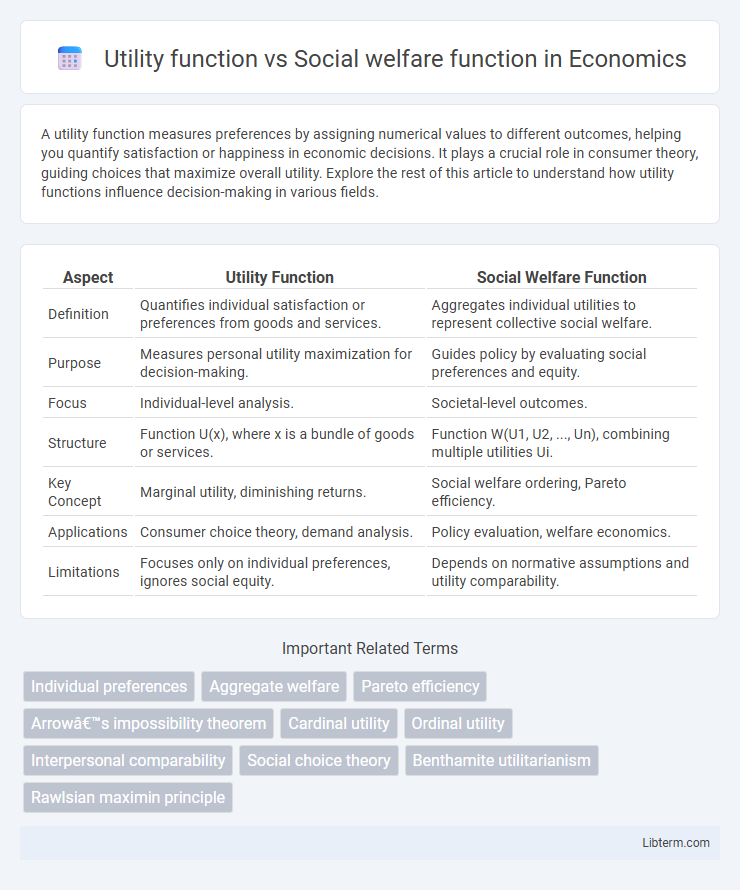A utility function measures preferences by assigning numerical values to different outcomes, helping you quantify satisfaction or happiness in economic decisions. It plays a crucial role in consumer theory, guiding choices that maximize overall utility. Explore the rest of this article to understand how utility functions influence decision-making in various fields.
Table of Comparison
| Aspect | Utility Function | Social Welfare Function |
|---|---|---|
| Definition | Quantifies individual satisfaction or preferences from goods and services. | Aggregates individual utilities to represent collective social welfare. |
| Purpose | Measures personal utility maximization for decision-making. | Guides policy by evaluating social preferences and equity. |
| Focus | Individual-level analysis. | Societal-level outcomes. |
| Structure | Function U(x), where x is a bundle of goods or services. | Function W(U1, U2, ..., Un), combining multiple utilities Ui. |
| Key Concept | Marginal utility, diminishing returns. | Social welfare ordering, Pareto efficiency. |
| Applications | Consumer choice theory, demand analysis. | Policy evaluation, welfare economics. |
| Limitations | Focuses only on individual preferences, ignores social equity. | Depends on normative assumptions and utility comparability. |
Understanding Utility Functions: An Overview
Utility functions quantify individual preferences by assigning numerical values to different choices, enabling the measurement of satisfaction or happiness derived from goods and services. Social welfare functions aggregate these individual utilities to evaluate overall societal well-being, guiding collective decision-making for resource allocation. Understanding utility functions is essential for interpreting how individual preferences influence economic models and social welfare assessments.
Defining Social Welfare Functions
Social welfare functions aggregate individual utility functions to evaluate the overall well-being of a society by incorporating preferences, fairness, and distribution considerations. Unlike individual utility functions, which measure personal satisfaction, social welfare functions provide a comprehensive framework to assess collective welfare and rank social states. Key examples include the utilitarian function, which sums utilities, and the Rawlsian function, which focuses on the welfare of the least advantaged.
Theoretical Foundations: Origins and Evolution
The theoretical foundations of utility functions trace back to classical economic theory, where individual preferences and choices form the basis for quantifying satisfaction through ordinal or cardinal utility. Social welfare functions emerged from welfare economics, formalized by Arrow's Impossibility Theorem and later refined by economists like Samuelson and Bergson, focusing on aggregating individual utilities into a collective social preference ranking. The evolution of these concepts reflects a shift from individualistic utility maximization toward normative frameworks aiming to reconcile equity and efficiency in societal well-being assessments.
Individual Preferences and Utility Measurement
Utility function captures individual preferences by assigning numerical values to different outcomes, reflecting personal satisfaction or happiness levels. Social welfare function aggregates these individual utilities to evaluate collective well-being, often incorporating principles of fairness or equity. Measuring utility involves cardinal or ordinal scales to represent intensity of preferences, while social welfare functions balance these individual utilities to guide policy decisions promoting overall societal welfare.
Aggregation of Preferences: From Individuals to Society
Utility functions represent individual preferences by assigning a numerical value to different choices, reflecting personal satisfaction. Social welfare functions aggregate these individual utilities into a collective measure that guides societal decision-making. This aggregation process involves balancing diverse preferences to achieve an overall social optimum, often addressing issues of fairness and Pareto efficiency.
Mathematical Formulations: Utility vs. Social Welfare
Utility functions represent individual preferences mathematically by assigning a numerical value to each possible outcome, reflecting the satisfaction or utility gained by a single agent. Social welfare functions aggregate these individual utilities into a collective measure, often through summation or weighted averages, to evaluate the overall well-being of a society. Key mathematical formulations include the utilitarian social welfare function W(U) = U_i, which sums individual utilities U_i, and the Rawlsian function W(U) = min{U_i}, emphasizing the welfare of the least advantaged agent.
Key Differences Between Utility and Social Welfare Functions
Utility functions represent individual preferences, quantifying personal satisfaction or happiness from consuming goods and services, while social welfare functions aggregate these utilities to evaluate overall societal well-being. Utility functions are ordinal and focus on individual choices, whereas social welfare functions require interpersonal comparisons and ethical judgments to balance equity and efficiency across the population. The key difference lies in utility functions reflecting singular perspectives, and social welfare functions providing a collective evaluation that guides policy decisions aiming to enhance social welfare.
Applications in Economic Policy and Decision Making
Utility functions quantify individual preferences by assigning numerical values to different outcomes, enabling policymakers to model consumer behavior and optimize resource allocation. Social welfare functions aggregate these individual utilities into a collective measure, guiding decisions that balance equity and efficiency in economic policy design. Applications include taxation strategies, public goods provision, and welfare programs, where social welfare functions help policymakers evaluate trade-offs between overall economic welfare and income distribution.
Limitations and Criticisms of Both Functions
Utility functions often face criticism for their inability to capture interpersonal comparisons of utility, making it difficult to aggregate individual preferences into a coherent social choice. Social welfare functions are limited by Arrow's Impossibility Theorem, which demonstrates the challenge of fulfilling all fairness criteria simultaneously, such as non-dictatorship, Pareto efficiency, and independence of irrelevant alternatives. Both models struggle with subjective value measurement and the ethical implications of aggregating diverse individual utilities into a single social metric.
Future Directions in Welfare Economics
Future directions in welfare economics emphasize integrating utility functions with social welfare functions to better capture intergenerational equity and preference heterogeneity. Advances in computational methods and behavioral economics enable more accurate modeling of individual utility valuations, enhancing social welfare aggregation frameworks. Emerging research also explores dynamic social welfare functions that incorporate uncertainty and climate change impacts, promoting sustainable policy design.
Utility function Infographic

 libterm.com
libterm.com